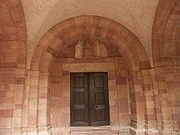
Andlau Abbey
Encyclopedia

Andlau
Andlau is a commune in the Bas-Rhin department in Alsace in north-eastern France.The village owes its origin to Andlau Abbey which was founded in AD 880 by Richardis, the Empress of Charles the Fat...
in Alsace
Alsace
Alsace is the fifth-smallest of the 27 regions of France in land area , and the smallest in metropolitan France. It is also the seventh-most densely populated region in France and third most densely populated region in metropolitan France, with ca. 220 inhabitants per km²...
, eastern France
France
The French Republic , The French Republic , The French Republic , (commonly known as France , is a unitary semi-presidential republic in Western Europe with several overseas territories and islands located on other continents and in the Indian, Pacific, and Atlantic oceans. Metropolitan France...
.
History
Andlau Abbey was founded in or about 880880
Year 880 was a leap year starting on Friday of the Julian calendar.- Religion :* Pope John VIII issues the bull Industriae Tuae, creating an independent ecclesiastical province in Great Moravia with Archbishop Saint Methodius as its head...
by Richardis
Richardis
Saint Richardis, also known as Richgard and Richardis of Swabia , was the Holy Roman Empress as the wife of Charles the Fat. She was renowned for her piety.-Life:...
, later Saint Richardis, Empress of Charles the Fat
Charles the Fat
Charles the Fat was the King of Alemannia from 876, King of Italy from 879, western Emperor from 881, King of East Francia from 882, and King of West Francia from 884. In 887, he was deposed in East Francia, Lotharingia, and possibly Italy, where the records are not clear...
, on her ancestral lands. The foundation legend states that the abbey was sited where Richardis saw a she-bear scratching at the soil; a bear is one of her emblems in reference to this. In 887 Richardis was put to the ordeal by fire by her husband on the pretext of adultery with the chancellor Liutward
Liutward
Liutward was the archchancellor of the Carolingian Empire from 878 and the bishop of Vercelli from 880 by appointment of Charles the Fat, whose chief minister he was. He should not be confused with his predecessor in this office of the same name, who would be archbishop of Mainz...
. She survived the ordeal successfully and withdrew to Andlau, where at the time her niece Rotrod was abbess. She died here in about 895 and was buried in the abbey church.
The abbey survived the Reformation
Protestant Reformation
The Protestant Reformation was a 16th-century split within Western Christianity initiated by Martin Luther, John Calvin and other early Protestants. The efforts of the self-described "reformers", who objected to the doctrines, rituals and ecclesiastical structure of the Roman Catholic Church, led...
, thanks to the efforts of the Abbess Rebstock, who is commemorated in the present church, but not the French Revolution
French Revolution
The French Revolution , sometimes distinguished as the 'Great French Revolution' , was a period of radical social and political upheaval in France and Europe. The absolute monarchy that had ruled France for centuries collapsed in three years...
.
Buildings

Paul of Tarsus
Paul the Apostle , also known as Saul of Tarsus, is described in the Christian New Testament as one of the most influential early Christian missionaries, with the writings ascribed to him by the church forming a considerable portion of the New Testament...
. The original buildings were from around 880. The abbey was entirely rebuilt in the first half of the 11th century. When Pope Leo XI
Pope Leo XI
Pope Leo XI , born Alessandro Ottaviano de' Medici, was Pope from 1 April 1605 to 27 April of the same year.-Biography:...
passed through Andlau in November of that year he was able to translate the remains of the canonised Richardis from the old church to the new Romanesque
Romanesque architecture
Romanesque architecture is an architectural style of Medieval Europe characterised by semi-circular arches. There is no consensus for the beginning date of the Romanesque architecture, with proposals ranging from the 6th to the 10th century. It developed in the 12th century into the Gothic style,...
one. Nothing remains of the first buildings (except for a hole in the floor of the crypt
Crypt
In architecture, a crypt is a stone chamber or vault beneath the floor of a burial vault possibly containing sarcophagi, coffins or relics....
said to have been made by the she-bear). The crypt itself dates from the 11th century. Another major re-construction took place in the 12th century after a serious fire, and another in the 15th century. The nave was completely rebuilt in the late 17th century. The present tomb of Saint Richardis dates from 1350, and is sited in a Baroque
Baroque architecture
Baroque architecture is a term used to describe the building style of the Baroque era, begun in late sixteenth century Italy, that took the Roman vocabulary of Renaissance architecture and used it in a new rhetorical and theatrical fashion, often to express the triumph of the Catholic Church and...
chapel of 1707.
The church is however most notable for its rich sculptural decoration, which is among the finest in Alsace. It is located on the Route Romane d'Alsace
Route Romane d'Alsace
The Route Romane d'Alsace is a touristic itinerary designed by the Association Voix et Route Romane to link both the well-known and the more secret examples of Romanesque architecture of Alsace, in an itinerary of 19 stages, linking churches, abbeys and fortresses, that range from the first...
.

